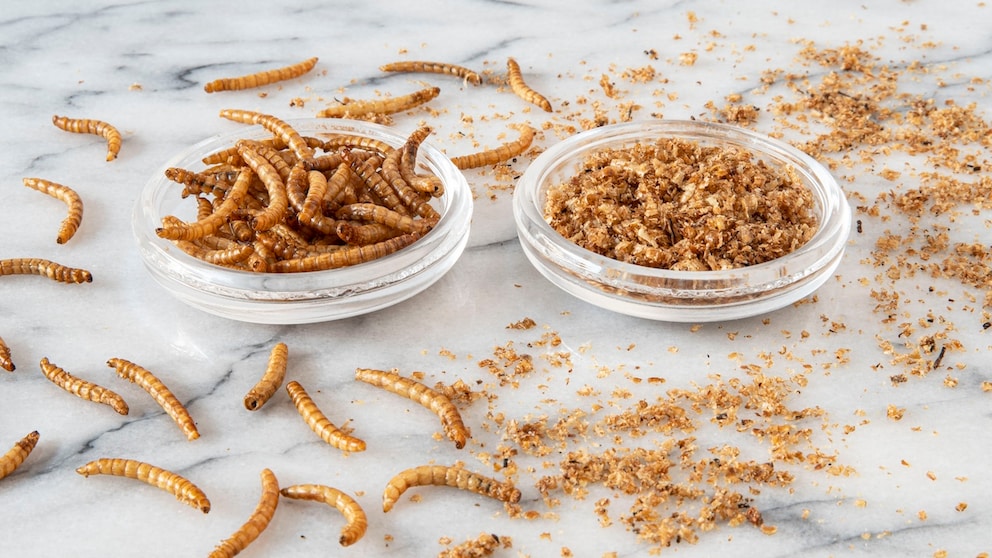February 17, 2025, 3:18 pm | Read time: 4 minutes
Insects are considered a delicacy in many countries around the world. In this country, people rarely eat insects on skewers, but they are also permitted as a food ingredient in the EU. This raises many questions for consumers. Among other things: Where are insects included, and how can I tell?
Insects as an ingredient in food are still a relatively new concept in the United States. In 2021, the European Commission approved the migratory locust and the flour beetle as novel foods; in 2022, the house cricket, also known as the cricket, and in 2023, the grain beetle.1 The mealworm (larvae of Tenebrio molitor) has now been approved in the form of UV-treated powder. However, so far, only one French company — which had submitted the application for approval — is allowed to market this powder for food.2 In general, any manufacturer wishing to use insects for food must apply for approval. But how can one recognize insects in food? Where are they found? What nutritional value do they offer? And, is it possible that they are secretly mixed into food? FITBOOK has the answers.
Overview
How to Recognize if Food Has Insects as an Ingredient
Insects as an ingredient are subject to mandatory labeling. This is important for allergy sufferers alone, as mealworms, grasshoppers, and other insects can trigger allergies. All you need to do is take a look at the list of ingredients. It must clearly and comprehensibly state where and in what form insects are present.
According to the European Commission, the requirements are:3
- Indication of the German and Latin name (for the house cricket approved in February 2022, this would be “Acheta domesticus” (house cricket))
- Information on the form of the admixture/form of administration (e.g., dried, paste-like, or powdered, for the newly authorized powder of the house cricket, thus “Partially defatted powder from Acheta domesticus (house cricket)”)
- Allergy information in the immediate vicinity of the list of ingredients (e.g., “Ingredient may cause allergic reactions in consumers known to be allergic to crustaceans, mollusks, and products thereof and house dust mites”)
It also states: “Consumers must not be misled; they must be able to decide for themselves whether or not to buy and consume food made from or containing insects.”
How Healthy Mealworms and Co. Are
Apart from the potential disgust factor of insects, on closer inspection, there is actually little that speaks against them as an ingredient in food. They have a high protein content and are much more environmentally friendly to produce than meat and fish, especially in terms of water consumption and greenhouse gas emissions. In addition, crickets, grasshoppers, and caterpillars contain large amounts of valuable vitamins and minerals with antioxidant (i.e., cancer-protecting) effects. According to the Italian study cited therein, vitamins A (beta-carotene), C, and E stand out in particular. In addition, the little animals ensure a proliferation of healthy intestinal bacteria. Last but not least, they are an excellent source of omega-3 and, therefore, a much more sustainable alternative to fish oil capsules.
List of Possible Food That Sometimes Has Insects
And where might insects be found in them? If you want to be on the safe side, you should read the small print of the following ready-made products:
- Baked goods such as cookies, crackers, and bread, as well as cakes
- Cereal bars
- Ready-made sauces
- Processed potato products, dishes based on pasta
- Meat substitutes (those labeled “vegan” do not contain insects)
- Chocolate products, including a colorant used for colored chocolate lentils
- Meat preparations
- Beverages similar to beer
- Cheese and cheese products
- Fruit and vegetable compotes
But don’t worry: according to the consumer advice center, insects in food are the exception rather than the rule because, as a so-called “novel food,” they are comparatively expensive.4 “With the average prices of more than 43 euros per 100 grams surveyed in the market sample, foods containing insects will otherwise continue to lead a niche existence,” writes the consumer advice center. Anyone who avoids highly processed foods as much as possible needs not to fear an accidental “insect meal” anyway.

Nutrition Expert Explains How the Portfolio Diet Works – and Who it is Suitable for

Nutrition tips from an expert 5 healthy snack recipes that keep blood sugar levels down

In large quantities Not just alcohol! 6 things that are harmful to the liver
Vegan Alternative, or Do Insects Have Feelings?
Current research suggests that insects do not experience pain or suffering in the same way mammals do. However, there are gaps in our knowledge that need to be filled to ensure that this assumption is correct. It should not be ignored that science has found sporadic neural and cognitive evidence that insects may have at least a significant perception of pain.5
Depending on the reasons why vegans and vegetarians have decided against animal products or meat, insects could be considered as a nutritious protein alternative. Incidentally, “Naturland,” an association for organic food, has set its own guidelines for insect farming.6 They may only be fed with organic plant by-products and residues from organic production – i.e., not with products intended for human consumption. This also conserves valuable resources.

